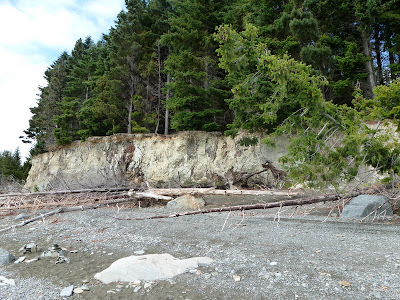We're going to fast-forward a few days here, so please excuse the time warp. But this post is time-sensitive. So we are now in Saturday, Jan. 14, in Napier, New Zealand. My cousin (Well, technically, she my second? half? once removed? cousin - but we've stopped caring.) is getting married today.
Now, for those of you who don't know Erica, she is, like myself, a science geek. The details of our interests may differ, but she has an absolute passion for and fascination with the natural world and its beauty and complexity. A few days ago, she wrote this post, that includes a re-telling of an origin-of-love story that speaks deeply to her, and to her feelings for Reuben (her husband-to-be). The story is so completely Erica - natural, flowing, ethereal.
I suggest that you go read it yourself, because I can't do it justice with a second re-telling. But the imagery of tumbling, rolling, speeding along, deeply connected to someone, without fully understanding how or why - Well, that inspired this unusual wedding tribute post on...avalanches!
Avalanches are a rather big deal in New Zealand. Gravity can certainly take a toll on all the steep cliffs, peaks, and mountains you've probably already seen in our photos. During our time on the South Island, we saw PLENTY of avalanche warning signs. Despite the light and upbeat tone of this post, avalanches are, in fact, serious business and can be extremely dangerous. I understand and respect this. Please do the same.
Now, let's take a peek at some examples of different kinds of avalanches we've seen. The cliffs here are high, and gravity is powerful and persistent, so avalanches can come in many shapes and sizes. For example:
1. Snow Avalanches. If you remember, photos from our trip to Milford Sound looked something like this:
 |
For a moment, ignore the subject in the center of the photo, and instead focus on the mountains behind him. We had to drive over/through them to get to the Sound. This is definitely avalanche territory in the winter. To help protect people on the road, helicopters are sent in to drop "bombs" on dangerous looking snow cliffs, purposely causing controlled avalanches. The fallen debris is cleared from the road, and the whole passage is safer than it was before. How clever is that??
2. Tree Avalanches. Carved out by glaciers, the sides of the Sounds are incredibly steep and rocky. But somehow, vegetation manages to grow -everything from grasses to trees. But again, gravity will always win. While we were in Doubtful Sound, our guide directed us to look at any of the steep cliff faces and note variations in the green color - light green to dark green.
 |
| The light green/brown areas extend vertically up from the water, about 1/3 of the way up the cliff. |
3. Avalanches on the glacier. We could see a similar phenomenon when we went on our glacier hike [plenty of photos on this are coming]. Everything that is grey or white at the bottom of the photo is glacier. Everything green higher up is "land". No trees here, mostly just grasses and bushes.
But look at the grey areas streaking down toward the glacier - these are avalanches of rocks that tumbled down onto the glacier. We actually hiked through parts of the green area in the upper left, and the guide said that there are times when hikes aren't permitted through, due to the risk of avalanches. This is usually after a heavy rain. At such high-risk times, the tour company actually positions lookouts on the hill to watch for tell-tale signs of an avalanche (plumes of smoke/dust, apparently, caused by the rocks banging together). He noted that, in this area, the area/path that we hiked is ever-changing, as newly fallen rocks block old paths and make way for new.
4. Beach Erosion. I don't think this really qualifies as an avalanche, but for any middle school science class unclear about the concept of erosion, these photos taken on the shores of Lake Pukaki (the lake is behind me) should clear things up quickly:
 |
| There's one on its way down on the right. |
A quick zoom-in reveals:
So, in conclusion - RESPECT GRAVITY!
But most of all: Congratulations, Reuben and Erica! May your lives continue to spin, tumble, and fall together in a crazy-wonderful way!




No comments:
Post a Comment